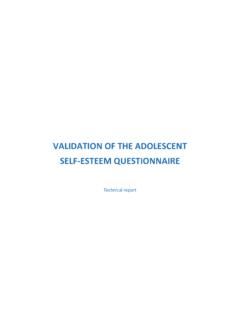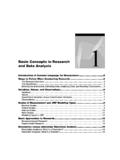Transcription of Child and Adolescent Mental Health and Educational Outcomes
1 Graduate School of Education Child and Adolescent Mental Health and Educational Outcomes An analysis of Educational Outcomes from Young Minds Matter: the second Australian Child and Adolescent Survey of Mental Health and Wellbeing Child and Adolescent Mental Health and Educational Outcomes An analysis of Educational Outcomes from Young Minds Matter: the second Australian Child and Adolescent Survey of Mental Health and Wellbeing Benjamin Goodsell David Lawrence John Ainley Michael Sawyer Stephen Zubrick John Maratos December 2017. Child and Adolescent Mental Health and Educational Outcomes : An analysis of Educational Outcomes from Young Minds Matter: the second Australian Child and Adolescent Survey of Mental Health and Wellbeing. ISBN: 978-1-74052-385-1.
2 This work was funded by the Australian Government Department of Education and Training. It makes use of data from Young Minds Matter: the second Australian Child and Adolescent Survey of Mental Health and Wellbeing. Young Minds Matter was funded by the Australian Government Department of Health . The survey was conducted in 2013-14 by the Telethon Kids Institute at The University of Western Australia in partnership with Roy Morgan Research. Additional information This report and additional information and results from Young Minds Matter can be downloaded from Suggested reference: Goodsell B, Lawrence D, Ainley J, Sawyer M, Zubrick SR, Maratos J (2017) Child and Adolescent Mental Health and Educational Outcomes . An analysis of Educational Outcomes from Young Minds Matter: the second Australian Child and Adolescent Survey of Mental Health and Wellbeing.
3 Perth: Graduate School of Education, The University of Western Australia. Contents Executive Summary 9. introduction 9. Key findings 10. Recommendations 12. 1 introduction 15. Young Minds Matter 15. Key findings of Young Minds Matter 15. Assessing Mental disorders 16. Access to NAPLAN data 17. Additional education-related data available in Young Minds Matter 18. Aims 19. School enrolment in the Young Minds Matter sample 19. Age, Year level and stage of schooling 20. Presentation of data and scope of this report 20. 2 Prevalence of Mental disorders and risk-taking behaviours in schools 22. Prevalence of Mental disorders in students who go to school 22. Prevalence of Mental disorders by Year in school 24. Prevalence of Mental disorders in students in the NAPLAN sample 28.
4 Prevalence of Mental disorders by socio-economic factors 30. Prevalence of risk-taking behaviours among students 35. Self-harm and suicidal behaviours 36. Summary 37. Child and Adolescent Mental Health and Educational Outcomes 5. 3 Academic Outcomes by Mental disorder 38. Any Mental disorder 39. Major depressive disorder 42. Anxiety disorders 45. ADHD 48. Oppositional problem behaviours and conduct disorder 51. Summary 54. 4 Academic trajectories and Mental disorders 55. Any Mental disorder 56. Major depressive disorder 58. Any anxiety disorder 60. ADHD 62. Oppositional problem behaviours and conduct disorder 64. Summary 66. 5 Academic trajectories, Mental disorders and service use 67. Any Mental disorder 68. Major depressive disorder 70. Any anxiety disorder 73.
5 ADHD 76. Oppositional problem behaviours and conduct disorder 78. Summary 80. 6 Attendance at school 81. Attendance rate 81. Distribution of days absent from school 83. Child and Adolescent Mental Health and Educational Outcomes 6. Days absent from school for individual Mental disorders 84. Absence from school, demographic and socio-economic factors 87. Days absent due to symptoms of Mental disorders 91. Summary 94. 7 Connectedness, engagement and dislike of school 95. Connectedness and engagement in school students 95. Connectedness and engagement in students who sat NAPLAN 96. Connectedness and engagement by Mental disorder 97. Connectedness and engagement and risk-taking behaviours 100. Dislike of school by Mental disorder 103. Summary 106. 8 Discussion of results 107.
6 introduction 107. Prevalence of Mental disorders and risk-taking behaviours in schools 108. Academic Outcomes by Mental disorder 108. Academic trajectories and Mental disorders 109. Academic trajectories, Mental disorders and service use 110. Attendance 110. Connectedness, engagement and dislike of school 111. Academic Outcomes by Mental disorder and socio-economic factors 112. Summary 114. 9 Discussion of implications 117. What are the policy implications of the results from this study? 117. Child and Adolescent Mental Health and Educational Outcomes 7. What services currently exist to help children and adolescents with Mental disorders in Australia? 119. What recommendations have been made to reduce Mental disorders in schools in other countries? 121.
7 What is the consensus of knowledge in this area? 122. Is there a larger role for school counsellors in this area? 123. Study limitations 126. Summary 126. Acknowledgements 128. References 129. Appendix 1 Glossary 133. Appendix 2 Academic Outcomes by Mental disorder and socio-economic factors 142. Family type 142. Household income 147. Parent and/or carer education 150. Parent and/or carer labour force status 153. Area of residence 158. Family functioning 162. School ICSEA 167. Summary 170. Appendix 3 Project scope 172. Child and Adolescent Mental Health and Educational Outcomes 8. Executive Summary introduction Young Minds Matter: The second Australian Child and Adolescent Survey of Mental Health and Wellbeing was part of the National Survey of Mental Health and Wellbeing initiative, an Australian Government Department of Health funded initiative.
8 It was conducted in 2013-14. and surveyed 6,310 families with children and adolescents aged 4-17 years. Survey participants were screened for several disorders including: major depressive disorder, anxiety disorders (generalised anxiety, social phobia, separation anxiety, and obsessive-compulsive disorder), and behavioural disorders (Attention-Deficit/Hyperactivity Disorder (ADHD), conduct disorder, and oppositional problem behaviours). Of the families surveyed, 5,051 gave consent to access their NAPLAN results for an analysis of children's Mental disorders in relation to Educational Outcomes . Funded by the Australian Government Department of Education, this analysis used NAPLAN data, including scaled scores, bands and categories (below, at, or above the National Minimum Standard), as provided by each of the state and territory testing authorities.
9 Key questions that were prioritised by the analysis were: How many students with low connectedness or engagement at school have Mental disorders? Is a current Mental disorder associated with poorer academic Outcomes ? How does this vary by type of Mental disorder? How much of the association between Mental disorders and academic Outcomes can be attributed to differences in attendance, and to socio-economic factors that are associated with Mental disorders? Does onset of Mental disorder alter trajectories of academic achievement? Do students receiving services for Mental disorders either within schools or within the Health sector have different trajectories of academic achievement? Child and Adolescent Mental Health and Educational Outcomes 9. Key findings Mental disorders are common in Australian school students While the original Young Minds Matter report focused on all children and adolescents, this analysis focused on students only.
10 Mental disorders affected 1 in 7 school students, with slightly higher prevalence in males than females. ADHD is the most common emotional or behavioural disorder in Australian school students, and is more common in males than females. ADHD affected 1 in 10 males, while affecting less than 1 in 20 females. After ADHD, the most prevalent disorders affecting students were anxiety disorders, and oppositional problem behaviours. Major depressive disorder was uncommon in children aged 4-11 years, but was more common in adolescents 12-17 years, affecting almost 1 in 20 adolescents, and was also the most common disorder in older Adolescent girls. Students with Mental disorders have poorer NAPLAN results NAPLAN occurs in Years 3, 5, 7 and 9, over five different domains: grammar, reading, spelling, writing and numeracy.






